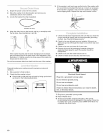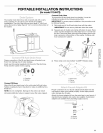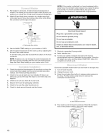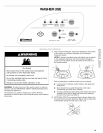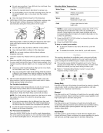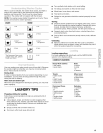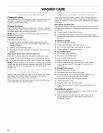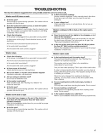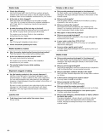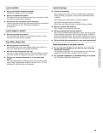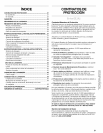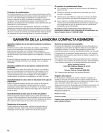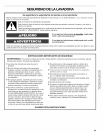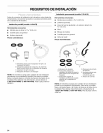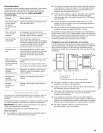
Washer leaks
Check the following:
Are the fill hoses tight? Are the fill hose washers properly
seated? Is the drain hose clamp or faucet adapter properly
installed? Refer to the installation instructions for your model.
Is the sink or drain clogged?
Sink, floor drain and standpipe must be able to handle
7 gal. (26.6 L) of water per minute for portable installations
and 13 gal. (49.2 L) of water per minute for permanent
installations.
Is water bouncing off the tub ring or the load?
The wash load should be balanced and not overloaded. If
not, the fill or spray rinses can bounce off the load,
The washer must be level. Refer to the installation
instructions for your model.
Did you install the drain hose in a standpipe or laundry
tub?
See "Permanent Installation Instructions."
• Check household plumbing for leaks.
Washer basket is crooked
• Was the washer basket pulled forward during loading?
Push the basket to the center before starting wash.
• Is the load balanced and the washer level?
The wash load should be balanced.
The washer must be level. Refer to the installation
instructions for your model.
• The washer basket moves while washing.
This is normal.
Dispensers clogged or leaking
Are the laundry products in the correct dispenser?
Add the correct amounts of powdered detergent, liquid
chlorine bleach, or fabric softener to the correct dispenser.
You can add powdered color safe bleach to the detergent
dispenser. Liquid detergent should be added to the bottom of
the washer basket.
Be sure to match powdered color-safe bleach with powdered
detergent or match liquid color-safe bleach with liquid
detergent. Use only liquid chlorine bleach in the bleach
dispenser.
Load too wet
• Cold rinses leave loads wetter than warm rinses.
This is normal.
Residue or lint on load
Did you add powdered detergent to the dispenser?
For best results, use the dispenser to dissolve powdered
detergent. Add liquid detergent directly to the bottom of the
washer basket.
Did you sort properly?
Sort lint givers (towels, chenille) from lint takers (corduroy,
synthetics). Also sort by color.
Did you overload the washer?
The wash load must be balanced. See "Starting Your
Washer" for maximum load size. Lint can be trapped in the
load if overloaded. Wash smaller loads.
Was paper or tissue left in pockets?
Did you use enough detergent?
Follow manufacturer's directions. Use enough detergent to
hold the lint in the water.
Is your water colder than 70°F (21°0)?
Wash water colder than 70°F (21°C) may not completely
dissolve the detergent.
Are you using a gentle wash cycle?
Consider using liquid detergent for slow-speed cycles such
as Hand-Wash.
Stains on load
Did you add powdered detergent to the dispenser?
For best results, use the dispenser to dissolve powdered
detergent. Add liquid detergent directly to the bottom of the
washer basket.
Did you use enough detergent?
Use enough detergent to remove soil and hold it in suspension.
Add the manufacturer's recommended amounts.
Did you add fabric softener directly to the load?
Use your fabric softener dispenser. Do not drip fabric softener
on clothes.
Is there above average iron (rust) in water?
You may need to install an iron filter.
Did you properly sort the load?
Sort dark clothes from whites and lights.
Did you unload the washer promptly?
To avoid dye transfer, unload the washer as soon as it stops.
Did you use powder detergent in a low-speed cycle?
Consider using liquid detergent.
Did you add detergent, chlorine bleach or fabric softener
too late in the cycle?
Powdered detergent, chlorine bleach, and fabric softener
should be added to the dispensers before starting the
washer. Add liquid detergent directly to the bottom of the
washer basket.
18



